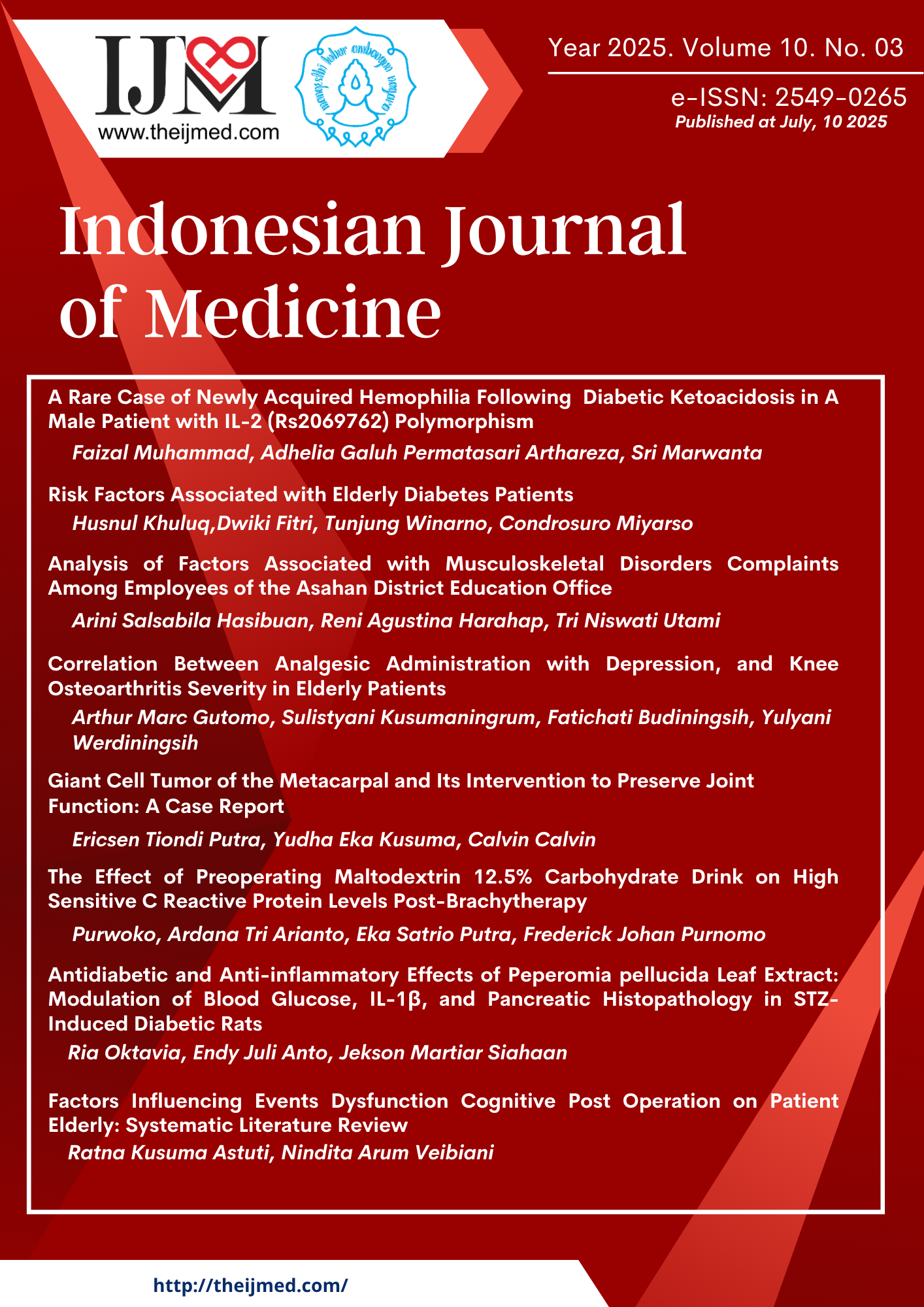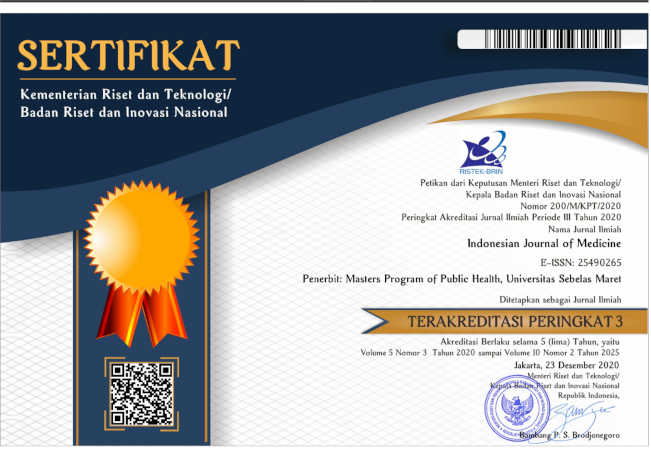Risk Factors Associated with Elderly Diabetes Patients
DOI:
https://doi.org/10.26911/theijmed.2025.10.3.775Abstract
Background: Diabetes mellitus is a chronic disease with increasing global prevalence, including in Indonesia. Among the elderly, its management is more complex due to age-related physiological changes and comorbidities. This study aimed to identify and analyze risk factors associated with diabetes in the elderly population.
Subjects and Method: This retrospective cross-sectional study analyzed medical records of 1,634 inpatients with type 2 diabetes mellitus at PKU Muhammadiyah Hospital Yogyakarta from January 2021 to July 2023. Total sampling was used. Data on demographics, comorbidities, and laboratory values were analyzed using Chi-square test.
Results: Of 1,634 patients, 853 (52.52%) were aged >65 years. Significant risk factors associated with elderly diabetes included elevated erythrocytes (OR= 1.60; 95% CI= 1.32–1.96; p <0.001), urea (OR= 1.51; 95% CI= 1.23–1.86; p <0.001), lymphocytes (OR= 1.26; 95% CI = 1.04–1.53; p= 0.020), hemoglobin (OR= 1.38; 95% CI = 1.14–1.68; p <0.001), systolic blood pressure (OR= 1.33; 95% CI= 1.07–1.65; p= 0.009), stroke (OR= 1.59; 95% CI = 1.09–2.32; p= 0.016), creatinine (OR= 1.24; 95% CI= 1.02–1.51; p= 0.028), and hypertension (OR= 1.29; 95% CI = 1.03–1.63; p= 0.028). Conversely, cholesterol (OR= 0.89; 95% CI= 0.65–1.23; p<0.001), and glucose (OR= 0.65; 95% CI= 0.51–0.83; p <0.001) were inversely associated.
Conclusion: Elderly diabetes is significantly associated with multiple clinical and laboratory indicators. These findings highlight the importance of comprehensive monitoring to improve elderly diabetes management.
Keywords:
elderly, diabetes, diabetes management, hypertensionReferences
Arkew M, Hailu E, Mengesha B, Moges N, Abate E, Degu G (2021). Hemato-logical parameters of type 2 diabetic adult patients at Debre Berhan Referral Hospital, Northeast Ethiopia: a comparative cross-sectional study. PLoS One. 16(6): e0253286. Doi: 10.1371/journal.-pone.0253286
Bjornstad P, Maahs DM, Duca L, Cherney DZI (2019). Elevated serum uric acid is associated with greater risk for hypertension and diabetic kidney diseases in obese adolescents with type 2 diabetes: an observational analysis from the treatment options for type 2 diabetes in adolescents and youth (TODAY) study. Diabetes Care. 42(6): 1120–1128. Doi: 10.2337/dc18-2147
Chew BH, Shariff-Ghazali S, Ismail SB (2013). Age ≥ 60 years was an independent risk factor for diabetes-related complications despite good control of cardiovascular risk factors in patients with type 2 diabetes mellitus. Exp Gerontol. 48(5): 485–491. Doi: 10.1016/j.exger.2013.02.017
Das U, Kar N (2023). Prevalence and risk factor of diabetes among the elderly people in West Bengal: evidence-based LASI 1st wave. BMC Endocr Disord. 23(1): 170. Doi: 10.1186/-s12902-023-01421-3
Demirtas L, Buyukbese MA, Yilmaz M, Ozcan I (2015). Association of hema-tological indices with diabetes, im-paired glucose regulation and micro-vascular complications of diabetes. Int J Clin Exp Med. 8(7): 11420–11427. https://pmc.ncbi.nlm.nih.gov/articles/PMC4565341/.
Engström G, Risérus U, Lampa E, Hedblad B, Lindgärde F (2014). Red cell distribution width, haemoglobin A1c and incidence of diabetes mellitus. J Intern Med. 276(2): 174–183. Doi: 10.1111/joim.12188
Halter JB, Musi N, McFarland HF, Vellas B, Beard JR (2014). Diabetes and cardiovascular disease in older adults: current status and future directions. Diabetes. 63(8): 2578–2589. Doi: 10.2337/db14-0020.
Harding JL, Pavkov ME, Magliano DJ, Shaw JE, Gregg EW (2019). Global trends in diabetes complications: a review of current evidence. Diabeto-logia. 62(1): 3–16. Doi: 10.1007/s0-0125-018-4711-2
Iglay K, Hannachi H, Joseph Howie P, Xu J, Li X, Engel SS (2016). Prevalence and co-prevalence of comorbidities among patients with type 2 diabetes mellitus. Curr Med Res Opin. 32(7): 1243–1252. Doi: 10.1185/03007995.-2016.1168291
Iwase M, Shimoda S, Saito K, Takagi T, Kajiwara A, Fukui T (2021). Inci-dence of stroke and its association with glycemic control and lifestyle in Japanese patients with type 2 dia-betes mellitus: the Fukuoka diabetes registry. Diabetes Res Clin Pract. 172: 108518. Doi: 10.1016/j.diabres.-2020.108518
Kementerian Kesehatan RI (2020). Info-datin tetap produktif, cegah, dan atasi diabetes melitus 2020. Pusat Data dan Informasi Kementerian Kesehatan RI. 1–10
Ki M, Moon S, Lee S (2014). Age-related differences in diabetes care outcomes in Korea: a retrospective cohort study. BMC Geriatr. 14(1): 111. Doi: 10.1186/1471-2318-14-111
Kurniawan MR, Kusrini E (2020). Ureum and creatinine health study in pati-ents diabetes mellitus. Indones J Med Lab Sci Technol. 2(2): 85–92. Doi: 10.33086/ijmlst.v2i2.1565
LeRoith D, Biessels GJ, Braithwaite SS, Casanueva FF, Dagogo-Jack S, De Groot M, Feinglos MN, et al. (2019). Treatment of diabetes in older adults: an endocrine society clinical practice guideline. J Clin Endocrinol Metab. 104(5): 1520–1574. Doi: 10.1210/jc.2019-00198
Ling S, Tan KC, Chan JC (2021). Glucose control, sulfonylureas, and insulin treatment in elderly people with type 2 diabetes and risk of severe hypo-glycemia and death: an observational study. Diabetes Care. 44(4): 915–924. Doi: 10.2337/dc20-0876
Lippi G, Targher G, Montagnana M, Salvagno GL, Guidi GC, Zoppini G (2014). Increased red blood cell distribution width (RDW) is associated with higher glycosylated hemoglobin (HbA1c) in the elderly. Clin Lab. 60(12): 2095–2098. Doi: 10.7754/clin.lab.2014.140621
Lipska KJ, Karter AJ, Huang ES, Moffet HH, Kwan ML (2023). Glycemic control and diabetes complications across health status categories in older adults treated with insulin or insulin secretagogues: the diabetes & aging study. J Am Geriatr Soc. 71(12): 3692–3700. Doi: 10.1111/jgs.18565
Milosevic D, Panin VL (2019). Relationship between hematological parameters and glycemic control in type 2 diabe-tes mellitus patients. J Med Biochem. 38(2): 164–171. Doi: 10.2478/jomb-2018-0021
Oktaviyani P, Anggraini RI, Nurjannah S (2022). Prevalence and risk factors of hypertension and diabetes mellitus among the Indonesian elderly. Makara J Health Res. 26(1): 26–32. Doi: 10.7454/msk.v26i1.1329
Olson NC, Cushman M, Lutsey PL, Vanderboom RP, Jenny NS, Gottesman RF, Golden SH et al. (2023). Circulating differentiated and senescent lymphocyte subsets and incident diabetes risk in older adults: the cardiovascular health study. Endocrinol Diabetes Metab. 6(1): e384. Doi: 10.1002/edm2.384
Piątkiewicz P, Solnica B, Pietrzak B, Kryc-zka W (2016). Severe hypoglycaemia in elderly patients with type 2 diabe-tes and coexistence of cardiovascular history. Kardiol Pol. 74(8): 779–785. Doi: 10.5603/KP.a2016.0043
Saeedi P, Petersohn I, Salpea P, Malanda B, Karuranga S, Unwin N, Colagiuri S et al. (2019). Global and regional dia-betes prevalence estimates for 2019 and projections for 2030 and 2045: results from the international diabetes federation diabetes atlas, 9th edition. Diabetes Res Clin Pract. 157: 107843. Doi: 10.1016/j.diabres.-2019.107843
Sasaki N, Okamura T, Nakagawa T, Masuda S, Nakashima E, Yamashita T, Tada Y (2020). Risk of hypertension in middle-aged and elderly participants with newly diagnosed type 2 diabetes and prediabetes. BMJ Open Diabetes Res Care. 8(1): e001500. Doi: 10.1136-/bmjdrc-2020-001500
da Silva TE, Christine I, Djaputra EM (2020). Blood sugar levels with neutrophil-lymphocyte ratio as a marker of diabetes mellitus in elderly. J Widya Med Junior. 2(3): 203–208. Doi: 10.33508/jwmj.v2i3.-2667
Solymár M, Antal M, Borka K, Tóth F, Fülöp P (2018). Metformin induces significant reduction of body weight, total cholesterol and LDL levels in the elderly - a meta-analysis. PLoS One. 13(11): e0207947. Doi: 10.13-71/journal.pone.0207947
Whiting DR, Guariguata L, Weil C, Shaw J (2011). IDF diabetes atlas: global estimates of the prevalence of diabe-tes for 2011 and 2030. Diabetes Res Clin Pract. 94(3): 311–321. Doi: 10.1016/j.diabres.2011.10.029
Xanthopoulos A, Troupis T, Arampatzis G, Katsaros D (2021). Red blood cell distribution width in elderly hospita-lized patients with cardiovascular disease. World J Cardiol. 13(9): 503–513. Doi: 10.4330/wjc.v13.i9.503
Xie Y, Jiang L, Shi X, Guo X (2018). Blood urea nitrogen and risk of insulin use among people with diabetes. Diabetes Vasc Dis Res. 15(5): 409–416. Doi: 10.1177/1479164118785050
Xu G, Liu B, Sun Y, Du Y, Zhang J (2018). Prevalence of diagnosed type 1 and type 2 diabetes among US adults in 2016 and 2017: population based study. BMJ. 362: k1497. Doi: 10.1136/bmj.k1497
Yan Z, Wang H, Wang J, Chen L (2023). The interaction between age and risk factors for diabetes and prediabetes: a community-based cross-sectional study. Diabetes Metab Syndr Obes. 16: 85–93. Doi: 10.2147/DMSO.-S390857
Yang X, Lu F, Zheng X, Chen J (2019). Association between higher blood pressure and risk of diabetes mellitus in middle-aged and elderly Chinese adults. Diabetes Metab J. 43: 436–445. Doi: 10.4093/dmj.2019.0081
Yeap BB, Alfonso H, Flicker L, Hankey GJ, Jamrozik K, Norman PE (2015). Diabetes, myocardial infarction and stroke are distinct and duration-dependent predictors of subsequent cardiovascular events and all-cause mortality in older men. J Clin Endo-crinol Metab. 100(3): 1038–1047. Doi: 10.1210/jc.2014-3339
Zhang L, Wu Y, Wei X, Li X (2021). Dia-betes as an independent risk factor for stroke recurrence in ischemic stroke patients: an updated meta-analysis. Neuroepidemiology. 55(6): 427–435. Doi: 10.1159/000519327











